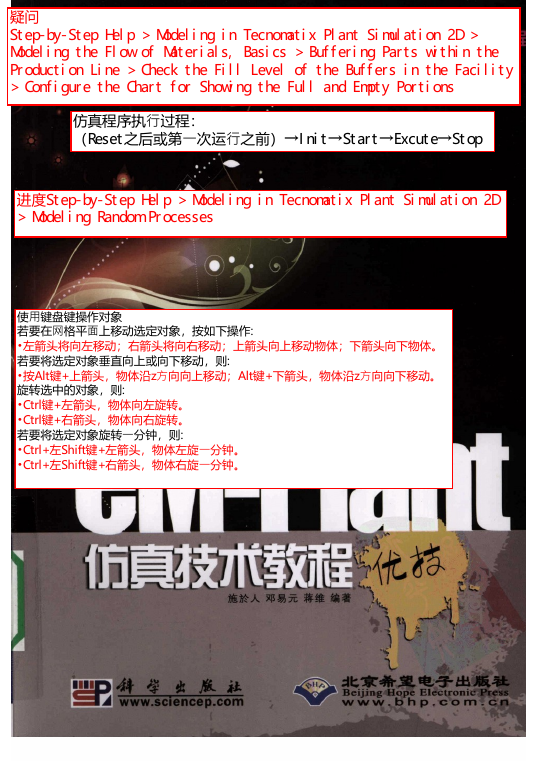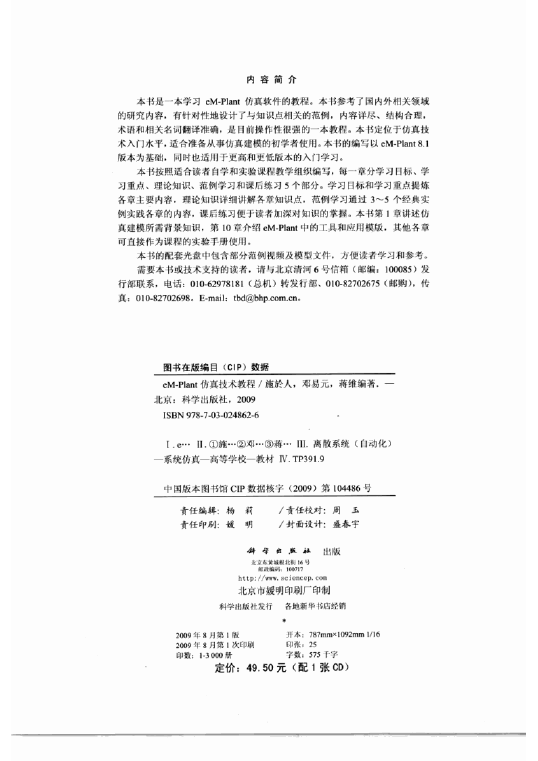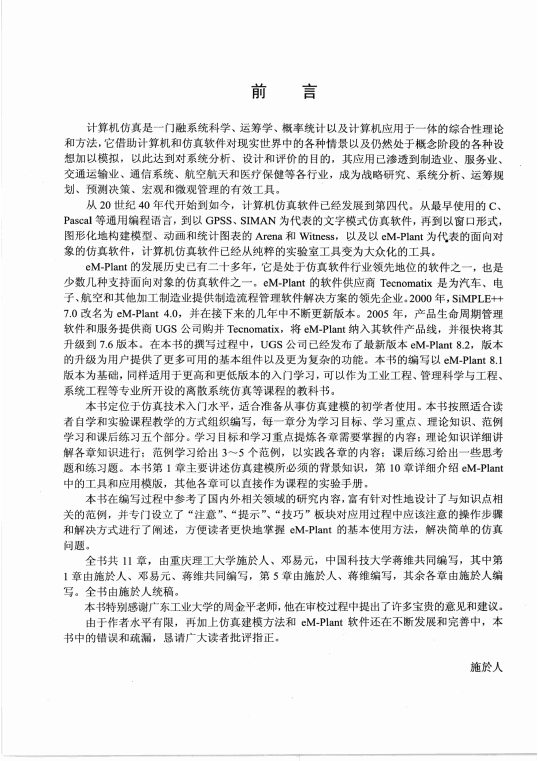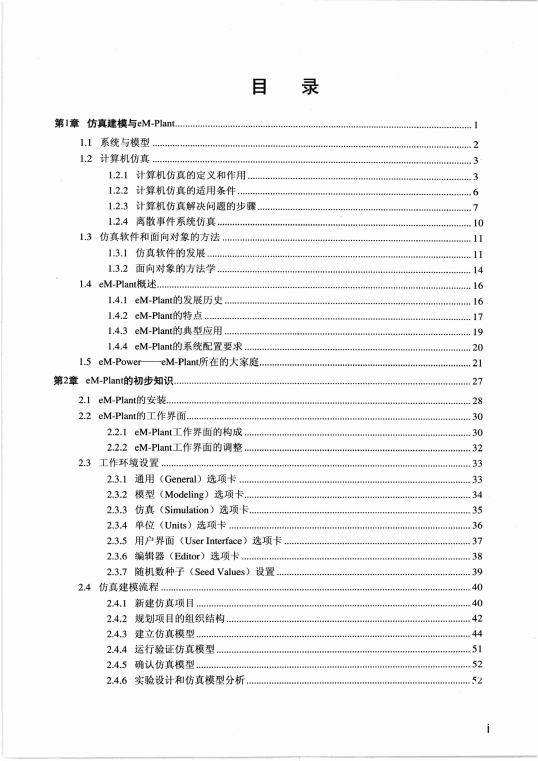EM-PLANT仿真技术教程.pdf
封面
书名
版权
前言
目录
第1章 仿真建模与eM-Plant
1.1 系统与模型
1.2 计算机仿真
1.2.1 计算机仿真的定义和作用
1.2.2 计算机仿真的适用条件
1.2.3 计算机仿真解决问题的步骤
1.2.4 离散事件系统仿真
1.3 仿真软件和面向对象的方法
1.3.1 仿真软件的发展
1.3.2 面向对象的方法学
1.4 eM-Plant概述
1.4.1 eM-Plant的发展历史
1.4.2 eM-Plant的特点
1.4.3 eM-Plant的典型应用
1.4.4 eM-Plant的系统配置要求
1.5 eM-Power——eM-Plant所在的大家庭
第2章 eM-Plant的初步知识
2.1 eM-Plant的安装
2.2 eM-Plant的工作界面
2.2.1 eM-Plant工作界面的构成
2.2.2 eM-Plant工作界面的调整
2.3 工作环境设置
2.3.1 通用(General)选项卡
2.3.2 模型(Modeling)选项卡
2.3.3 仿真(Simulation)选项卡
2.3.4 单位(Units)选项卡
2.3.5 用户界面(User Interface)选项卡
2.3.6 编辑器(Editor)选项卡
2.3.7 随机数种子(Seed Values)设置
2.4 仿真建模流程
2.4.1 新建仿真项目
2.4.2 规划项目的组织结构
2.4.3 建立仿真模型
2.4.4 运行验证仿真模型
2.4.5 确认仿真模型
2.4.6 实验设计和仿真模型分析
2.5 范例学习
范例1 创建第一个eM-Plant模型
范例2 对象的复制和继承
第3章 eM-Plant建模的基本元素——对象
3.1 对象的分类
3.2 物流对象
3.2.1 控制和框架类物流对象
3.2.2 生产类物流对象
3.2.3 运输类物流对象
3.2.4 资源类物流对象
3.2.5 设置物流对象的共同参数
3.3 信息流对象
3.4 用户接口对象
3.5 移动对象
3.5.1 Entity对象
3.5.2 Container对象
3.5.3 Transporter对象
3.6 移动对象的产生、回收和移动机制
3.6.1 移动对象的生成——Source对象
3.6.2 移动对象的回收——Drain对象
3.6.3 移动对象在物流对象中移动的原则
3.6.4 移动对象进出物流对象的控制
3.7 范例学习
实例1 使用EventController对象跟踪仿真事件
范例2 Source对象中Operating mode项的作用
范例3 物流对象准备环节(Set-Up)的设置
范例4 Trigger对象的应用
第4章 分流、动画和层式结构
4.1 分流的实现—FlowControl对象
4.1.1 离去策略(Exit Strategy)选项卡
4.1.2 进入策略(Entry Strategy)选项卡
4.2 层式结构的实现—Interface对象
4.3 图标编辑器(Icon Editor)
4.3.1 图标的创建和编辑
4.3.2 定义动画
4.3.3 显示动画和禁止显示动画
4.4 范例学习
范例1 图标参考点、动画点及动画线的设置和作用
范例2 分流和分流动画
范例3 层式结构
范例4 层式结构的动画设置
第5章 表和图
5.1 表
5.1.1 表的类型
5.1.2 定义表
1、统一定义的表的参数
2、定义列名
3、定义列的数据类型
4、定义行名
5.1.3 表中数据的存取
5.2 图
5.2.1 设置图的数据来源
5.2.2 设置图的其他参数
5.3 仿真数据的显示和保存
5.4 范例学习
范例1 栈表(StackFile)以及队列表(QueueFile)的存取
范例2 Chart对象的使用之一
范例3 Chart对象的使用之二
第6章 SimTalk语言和Method对象
6.1 SimTalk简介
6.1.1 SimTalk中的名称、保留字以及预定义Method对象
6.1.2 名称空间和访问路径
6.1.3 匿名指代符
6.1.4 SimTalk的数据类型和运算符
6.1.5 SimTalk的常量和变量
6.1.6 SimTalk的控制语句
6.1.7 系统函数
6.2 Method对象
6.2.1 Method对象的结构
6.2.2 Method调试器
6.2.3 Method对象的调用
6.3 全局变量——Variable对象
6.4 范例学习
范例1 Method调试器的使用
范例2 匿名指代符的使用
范例3 Variable对象的使用
范例4 Method对象的调用
第7章 物流对象——生产类物流对象
7.1 SingleProc对象和ParallelProc对象
7.2 Assembly对象
7.3 DismantleStation对象
7.4 Buffer对象、PlaceBuffer对象和Store对象
7.5 Sorter对象
7.6 Cycle对象
7.7 Generator对象
7.8 ShiftCalendar对象
7.9 范例学习
范例1 Assembly对象和DismantleStation对象的使用
范例2 Buffer对象和PlaceBuffer对象的使用
范例3 Store对象的使用
范例4 采用ShiftCalendar对象排班
范例5 Cycle对象的使用
第8章 物流对象——运输类物流对象
8.1 Line对象
8.2 Track对象
8.3 TurnTable对象
8.4 AngularConverter对象
8.5 TwoLaneTrack对象
8.6 Transporter对象
8.7 范例学习
范例1 Line对象的使用
范例2 Transporter对象的方向控制之一
范例3 Transporter对象的方向控制之二
范例4 Transporter对象的方向控制之三
第9章 物流对象——资源类物流对象
9.1 请求服务
9.2 提供服务
9.3 调度资源
9.4 Workplace对象和FootPath对象
9.5 范例学习
范例1 Exporter对象和Broker对象的使用
范例2 WorkerPool对象、Workplace对象及FootPath对象的使用
范例3 设置一组工人(Workers)提供多项服务(Services)
范例4 服务请求在Broker对象之间的传递
第10章 eM-Plant的工具、附加件及应用模版
10.1 工具
10.1.1 统计分析工具
10.1.2 实验工具
10.1.3 优化工具
10.2 附加件
10.3 应用模版
10.4 范例学习
范例1 DataFit对象的使用
范例2 Experiment工具的使用之一
范例3 Experiment工具的使用之二
第11章 综合应用案例
11.1 问题描述
11.2 建立模型
11.2.1 建模准备
11.2.2 放置对象
11.2.3 设置对象的参数
11.2.4 编写Method对象的程序内容
11.2.5 收集仿真运行结果
11.3 运行验证模型
11.3.1 确定仿真运行的次数
11.3.2 确定稳态开始时间
SimTALK
Lesson 1: Introduction to the Object Method
Introduction
The Object Method
Toolbar of the method
Options- Simulation
Lesson 2: Syntax for Writing a Method
Structure of a Method
Syntax of a Method
Sample Statements
SimTalk Operators
Document Conventions
Method Templates
Comments
Lesson 3: The Method Debugger
Introduction
The Debugger Toolbar
Breakpoints executing a method step-by-step
Exercise: Defining a method
Lesson 4: Names, Identifiers and Paths
Introduction
Name Space
Absolute Path
The Relative Path
Lesson 5: Anonymous Indentifiers
Introduction
Calling the MU Triggering the Method — @
Calling the Active Method – Self
Calling the Object Calling the Method — ?
Calling the Active Frame – Current
Calling the Location of the Active Frame – Location
Calling the Topmost Level of the Hierarchy – root
Exercise: Using the Anonymous Identifiers
Lesson 6: Scheduling Method Calls
Events in the Model - Calling Methods
The Method Reset
The Method init
Lesson 7: Entrance and Exit Controls
Introduction
Entrance Control of Location Oriented Objects
Front-Activated Exit Control of the Location Oriented Objects
Rear-Activated Exit Control of Location Oriented Objects
Front_Activated Entrance Control of Length Oriented Objects
Rear-Activated Entrance Control of Length Oriented Objects
Front_Activated Exit Control of Length Oriented Objects
Rear_Activated Exit Control of Length Oriented Objects
Backward Entrance and Exit Controls
Sensors of Length Oriented Objects
Moving an MU to the Next Object
Predecessors and Successors
Exercise 1: Entrance and Exit Control of a SingleProc
Exercise 2: Entrance and Exit Control of the Line Object
Lesson 7: Attributes
Introduction
Assigning a Value
Exercise: Changing the Attributes of an Object with a Method
Lesson 8: Conditional Statements
Branching using If Then
Branching using If Elseif
The Inspect Statement
Lesson 9: Tables and Global Variables
Introduction
Formatting the TableFile
Accessing the TableFile with a Method
Accessing a TableFile Using a Custom Index
Methods for Lists and Tables
Searching a TableFile
The Variable
Exercise 1: Painting the TableTops
Exercise 2: Test Painting
Exercise 3: The Paint Cycle
Exercise 4: Test and Add the Paint frame to Plant_8
The StackFile, QueueFile and CardFile
Method for Writing into StackFiles, QueueFiles and CardFiles.
Lesson 10: Operations Converting Data Types
Introduction
Logical Operators
Integer Operators
Real Operators
String Operators
Operator Precedence
Methods for Converting Data Types
Lesson 11: Loops
Introduction
The For Loop
The Repeat Until Loop
The While Loop
Example: Loops
Lesson 12: Conditional Suspensions – waituntil and stopuntil
Introduction
Lesson 13: The Contents of an Object Loading and Unloading
Introduction
The Container
Accessing the Contents of an Object
The contents of a Material Flow Object
Exercise 1: Creating the Assembly Loading Cycle
Exercise 2: Creating the Assembly Unloading Cycle
Exercise 3: The palette cycle
Accessing the Contents of a Location Oriented Object
Exercise 4: Attaching the Legs to the TableTops
Exercise 5: Testing the assembly and CompAssemblyComplete
Exercise 6: TestAssembly and Plant_8
Exercise 7: Conveyor for the TableLegs
Line – Define the Curve
Line Attributes
Lesson 14: Calling Methods; Trigger and Frame Controls
Introduction
Method Called by a Frame Control
Exercise: The Frame Control
Lesson 15: Resource Objects
Introduction
Assigning a Workplace to a Station
Defining services of a Station
Defining the Worker from the Workerpool
Exercise: Worker Assignment
Lesson 16: Miscellaneous Features
A Method as a Custom Attribute
Miscellaneous Methods
Built-in Method Icons
The Track
The Transporter
Methods of the Transporter
Exercise: Transporting MUs
Chapter Summary
















 2023年江西萍乡中考道德与法治真题及答案.doc
2023年江西萍乡中考道德与法治真题及答案.doc 2012年重庆南川中考生物真题及答案.doc
2012年重庆南川中考生物真题及答案.doc 2013年江西师范大学地理学综合及文艺理论基础考研真题.doc
2013年江西师范大学地理学综合及文艺理论基础考研真题.doc 2020年四川甘孜小升初语文真题及答案I卷.doc
2020年四川甘孜小升初语文真题及答案I卷.doc 2020年注册岩土工程师专业基础考试真题及答案.doc
2020年注册岩土工程师专业基础考试真题及答案.doc 2023-2024学年福建省厦门市九年级上学期数学月考试题及答案.doc
2023-2024学年福建省厦门市九年级上学期数学月考试题及答案.doc 2021-2022学年辽宁省沈阳市大东区九年级上学期语文期末试题及答案.doc
2021-2022学年辽宁省沈阳市大东区九年级上学期语文期末试题及答案.doc 2022-2023学年北京东城区初三第一学期物理期末试卷及答案.doc
2022-2023学年北京东城区初三第一学期物理期末试卷及答案.doc 2018上半年江西教师资格初中地理学科知识与教学能力真题及答案.doc
2018上半年江西教师资格初中地理学科知识与教学能力真题及答案.doc 2012年河北国家公务员申论考试真题及答案-省级.doc
2012年河北国家公务员申论考试真题及答案-省级.doc 2020-2021学年江苏省扬州市江都区邵樊片九年级上学期数学第一次质量检测试题及答案.doc
2020-2021学年江苏省扬州市江都区邵樊片九年级上学期数学第一次质量检测试题及答案.doc 2022下半年黑龙江教师资格证中学综合素质真题及答案.doc
2022下半年黑龙江教师资格证中学综合素质真题及答案.doc